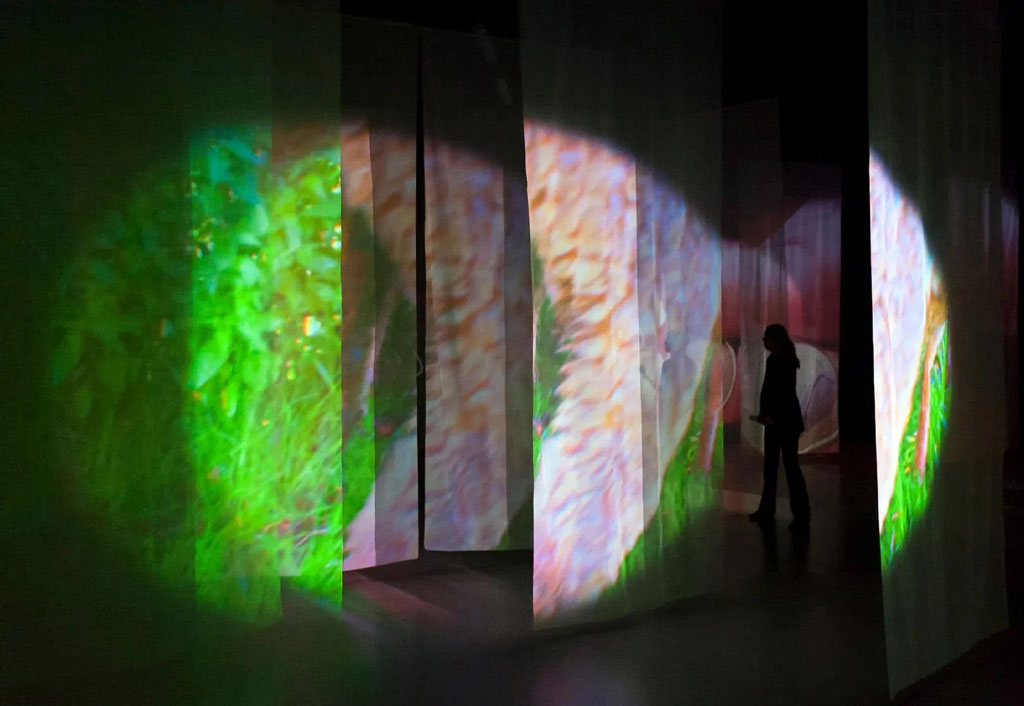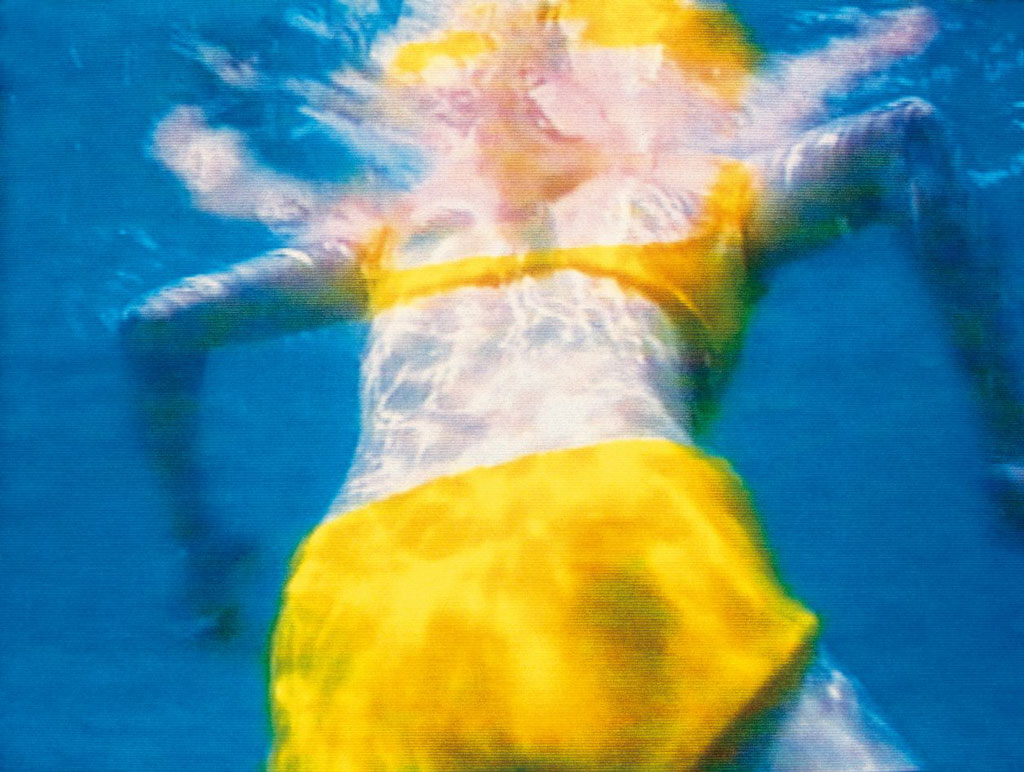TRACES: Pipilotti Rist
 Today is the occasion to bear in mind the visual artistPipilotti (Elisabeth) Rist (21/6/1962 -). She is best known for creating experimential video art and installations that often portrays self-portraits and singing. Her work is often described as surreal, intimate, abstract art, having a preoccupation with the female. Through documents or interviews, starting with: moments and memories, we reveal out from the past-unknown sides of big personalities, who left their indelible traces in time and history…
Today is the occasion to bear in mind the visual artistPipilotti (Elisabeth) Rist (21/6/1962 -). She is best known for creating experimential video art and installations that often portrays self-portraits and singing. Her work is often described as surreal, intimate, abstract art, having a preoccupation with the female. Through documents or interviews, starting with: moments and memories, we reveal out from the past-unknown sides of big personalities, who left their indelible traces in time and history…
By Efi Michalarou
 Born Elizabeth Rist in 1962 in Rheintal, Switzerland, Pipilotti Rist combined her childhood nickname, Lotti, with the first name of the Swedish children’s story character Pippi Longstocking to create her artistic moniker in 1982. She attended the Hochschule für Angewandte Kunst in Vienna from 1982 to 1986 and the Schule für Gestaltung Basel from 1986 to 1988. She produced her first video “I’m Not the Girl Who Misses Much” (1986), while still at school in Basel. In it, she bounces up and down, falling out of her dress, as she repeatedly sings the title line (derived from the lyrics to a Beatles song). From 1988 to 1994, she played in a rock band called Les Reines Prochaines, at the same time developing an aesthetic language quite close to that of music videos in her art. The artist appears in many of her own videos and often sings on the soundtracks; her mother, brother, and three sisters frequently assist on the production. Since emerging in the mid-1980s, Rist has drawn as much from the language of the mass media as she has from first-generation video artists like Nam June Paik. In particular, the saturated colors, hallucinatory effects, and prominent sound tracks of her works have elicited comparisons to the language of music videos. While exploiting the sensuous qualities of the medium, however, Rist eschews popular conventions of narrative and spectatorship, especially in the way that she presents female subjects. “Sip My Ocean” a video projected as two mirrored reflections on adjoining walls, offers a kaleidoscopic view of an idyllic underwater paradise, with a flowing sequence of dreamlike images, including intermittent close-ups of a bikini-clad woman floating and swimming through the waves along with views of various domestic objects sinking to the seabed. The implicit voyeurism and exaggerated hyperfeminity of such images are complicated by the accompanying sound track, in which the artist’s rendition of Chris Isaac’s melancholy pop song Wicked Game is punctuated by her repeated shrieking of the lyrics “I don’t want to fall in love”. Although she denies having an explicitly feminist agenda, Rist frequently merges eroticism and coquettishness with aggression and hysteria to produce provocative fantasies of female empowerment. Rist’s video installations since the mid-1990s have varied radically in scale and context, from a thumb-size monitor embedded in the floor to a billboard-size projection in New York’s Times Square. “Himalaya’s Sister’s Living Room” is one of several room-size environments in which she has explored domestic space. The work beckons the viewer into a dimly lit interior cluttered with furniture and objects from different eras, some of which are uncannily animated by videos cast from hidden projectors: on a side table, the artist presses her face against a windowpane; a liquor bottle atop a 1950s-era bar glows with a soccer game. Rist has noted that the “moving picture itself is always a room within another room”. Just as she employs video to explore the interiority of her female characters, here she uses projections to penetrate inanimate objects, uncovering the thoughts and memories embedded within the collective space of the household. In 1997 Rist received a Premio 2000 award at the Venice Biennale for the video “Ever Is Over All” (1997), in which a young woman smashes car windows with a large red flower. Three years later, with “Open My Glade” (2000), commissioned by the New York Public Art Fund, the artist broadcast a series of sixteen one-minute video segments on the largest video screen in Times Square in New York. Interspersed with television programming, this collection of short videos consisted of close-up shots of her face as she uttered poetic, philosophical, and political statements. In the multichannel video installation “Stir Heart, Rinse Heart” (2003), commissioned by the San Francisco Museum of Modern Art, found plastic objects, including egg cartons, clear tubes, and coffee-cup lids, hang from the ceiling, acting as mini animated screens catching projected images of waves and what seems to be magnified blood, all in saturated colors. For “A la belle étoile” (2007), Rist projected images of clouds, fireworks, distorted landscapes, and herself onto the piazza in front of the Centre Georges Pompidou in Paris, allowing visitors to view the projection from the top floors of the museum after dark. Her video installation at the Museum of Modern Art in New York “Pour Your Body Out (7354 Cubic Meters)” (2008), transformed the second-floor atrium into a Technicolor wonderland of orchards and seascapes. “Pour Your Body Out” expresses the artist’s wish to reconcile viewers with the perception of their own bodies and the surrounding environment through the acceptance of the unbelievable variety of beautiful and ugly forms that make up human beings and the world. In this work, Rist’s intent is to visualize an individual’s interior thought process on the walls of the atrium. At the same time, the title alludes to the impressive volume of the central atrium as an architectural structure.
Born Elizabeth Rist in 1962 in Rheintal, Switzerland, Pipilotti Rist combined her childhood nickname, Lotti, with the first name of the Swedish children’s story character Pippi Longstocking to create her artistic moniker in 1982. She attended the Hochschule für Angewandte Kunst in Vienna from 1982 to 1986 and the Schule für Gestaltung Basel from 1986 to 1988. She produced her first video “I’m Not the Girl Who Misses Much” (1986), while still at school in Basel. In it, she bounces up and down, falling out of her dress, as she repeatedly sings the title line (derived from the lyrics to a Beatles song). From 1988 to 1994, she played in a rock band called Les Reines Prochaines, at the same time developing an aesthetic language quite close to that of music videos in her art. The artist appears in many of her own videos and often sings on the soundtracks; her mother, brother, and three sisters frequently assist on the production. Since emerging in the mid-1980s, Rist has drawn as much from the language of the mass media as she has from first-generation video artists like Nam June Paik. In particular, the saturated colors, hallucinatory effects, and prominent sound tracks of her works have elicited comparisons to the language of music videos. While exploiting the sensuous qualities of the medium, however, Rist eschews popular conventions of narrative and spectatorship, especially in the way that she presents female subjects. “Sip My Ocean” a video projected as two mirrored reflections on adjoining walls, offers a kaleidoscopic view of an idyllic underwater paradise, with a flowing sequence of dreamlike images, including intermittent close-ups of a bikini-clad woman floating and swimming through the waves along with views of various domestic objects sinking to the seabed. The implicit voyeurism and exaggerated hyperfeminity of such images are complicated by the accompanying sound track, in which the artist’s rendition of Chris Isaac’s melancholy pop song Wicked Game is punctuated by her repeated shrieking of the lyrics “I don’t want to fall in love”. Although she denies having an explicitly feminist agenda, Rist frequently merges eroticism and coquettishness with aggression and hysteria to produce provocative fantasies of female empowerment. Rist’s video installations since the mid-1990s have varied radically in scale and context, from a thumb-size monitor embedded in the floor to a billboard-size projection in New York’s Times Square. “Himalaya’s Sister’s Living Room” is one of several room-size environments in which she has explored domestic space. The work beckons the viewer into a dimly lit interior cluttered with furniture and objects from different eras, some of which are uncannily animated by videos cast from hidden projectors: on a side table, the artist presses her face against a windowpane; a liquor bottle atop a 1950s-era bar glows with a soccer game. Rist has noted that the “moving picture itself is always a room within another room”. Just as she employs video to explore the interiority of her female characters, here she uses projections to penetrate inanimate objects, uncovering the thoughts and memories embedded within the collective space of the household. In 1997 Rist received a Premio 2000 award at the Venice Biennale for the video “Ever Is Over All” (1997), in which a young woman smashes car windows with a large red flower. Three years later, with “Open My Glade” (2000), commissioned by the New York Public Art Fund, the artist broadcast a series of sixteen one-minute video segments on the largest video screen in Times Square in New York. Interspersed with television programming, this collection of short videos consisted of close-up shots of her face as she uttered poetic, philosophical, and political statements. In the multichannel video installation “Stir Heart, Rinse Heart” (2003), commissioned by the San Francisco Museum of Modern Art, found plastic objects, including egg cartons, clear tubes, and coffee-cup lids, hang from the ceiling, acting as mini animated screens catching projected images of waves and what seems to be magnified blood, all in saturated colors. For “A la belle étoile” (2007), Rist projected images of clouds, fireworks, distorted landscapes, and herself onto the piazza in front of the Centre Georges Pompidou in Paris, allowing visitors to view the projection from the top floors of the museum after dark. Her video installation at the Museum of Modern Art in New York “Pour Your Body Out (7354 Cubic Meters)” (2008), transformed the second-floor atrium into a Technicolor wonderland of orchards and seascapes. “Pour Your Body Out” expresses the artist’s wish to reconcile viewers with the perception of their own bodies and the surrounding environment through the acceptance of the unbelievable variety of beautiful and ugly forms that make up human beings and the world. In this work, Rist’s intent is to visualize an individual’s interior thought process on the walls of the atrium. At the same time, the title alludes to the impressive volume of the central atrium as an architectural structure.














